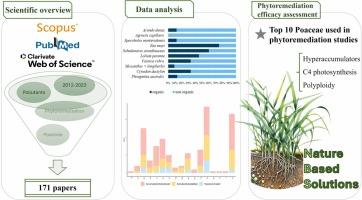植物修复中的禾科植物:当前知识、研究趋势和对有用植物性状的见解的系统综述
IF 11.3
1区 环境科学与生态学
Q1 ENGINEERING, ENVIRONMENTAL
引用次数: 0
摘要
环境污染是一个全球关注的问题,不同环境基质的质量评估对于开发基于自然的解决方案(NBS)(如植物修复)以减少生态风险至关重要。本文综述了禾科植物在植物修复中的应用,重点介绍了禾科植物在不同环境基质中修复的特性,并提出了提高植物修复效率的方法。以11年(2012-2023年)为时间段,从所选论文中提取30个变量进行研究:哪些物种和污染物研究最多,用于评估不同物种表现的标准,以及需要解决的植物修复过程方面,以制定更有效的NBS。对171篇精选论文的审查显示了研究最多的前10种物种。芦苇(芦苇科)指标。Steud交货。和长爪Cynodon dactylon (L.)珀耳斯。是最常用的污染物,而研究最多的污染物是潜在有毒元素(pte)。采用几种分析标准对禾本科植物的生理、分子和生化特性进行了评价。还探讨了根际相互作用的复杂网络。特别关注的是多倍体,这是大多数被调查物种的特征,突出了它在提高植物性能和抵抗高污染胁迫方面的巨大益处。本文的研究结果为推进禾本科植物修复在植物修复领域的应用提供了有价值的见解。本文章由计算机程序翻译,如有差异,请以英文原文为准。

Poaceae in phytoremediation: A systematic review of current knowledge, research trends and insights into useful plant traits
Environmental contamination is a global concern, and quality assessment of different environmental matrices is essential for developing Nature-Based Solutions (NBS) such as phytoremediation, to reduce ecological risks. This systematic review aims to collect all recent information on the application of Poaceae species in phytoremediation, highlighting plant traits useful for phytoremediation of different environmental matrices, and determining needed improvements to enhance NBS efficiency. A time period of 11 years (2012–2023) was considered, and 30 variables were extracted from the selected papers to investigate: which species and contaminants were the most studied, the criteria used to assess the performance of different species, and the phytoremediation process aspects that need to be addressed to develop more effective NBS. The review of 171 selected papers revealed the top 10 most studied species. Phragmites australis (Cav.) Trin. ex Steud., and Cynodon dactylon (L.) Pers. were the most frequently used, while the most studied contaminants were potentially toxic elements (PTEs). Several analytical criteria were assessed to evaluate thephysiological, molecular, and biochemical traits of Poaceae species. The complex network of rhizosphere interactions was also explored. Particular attention was reserved for polyploidy, which characterizes most of the investigated species, highlighting its huge benefits in enhancing plant performance and resistance to high contaminant stress due to genome duplication. The findings presented in this review provide valuable insights for advancing the field application of Poaceae in phytoremediation, which remains largely unexplored.
求助全文
通过发布文献求助,成功后即可免费获取论文全文。
去求助
来源期刊

Journal of Hazardous Materials
工程技术-工程:环境
CiteScore
25.40
自引率
5.90%
发文量
3059
审稿时长
58 days
期刊介绍:
The Journal of Hazardous Materials serves as a global platform for promoting cutting-edge research in the field of Environmental Science and Engineering. Our publication features a wide range of articles, including full-length research papers, review articles, and perspectives, with the aim of enhancing our understanding of the dangers and risks associated with various materials concerning public health and the environment. It is important to note that the term "environmental contaminants" refers specifically to substances that pose hazardous effects through contamination, while excluding those that do not have such impacts on the environment or human health. Moreover, we emphasize the distinction between wastes and hazardous materials in order to provide further clarity on the scope of the journal. We have a keen interest in exploring specific compounds and microbial agents that have adverse effects on the environment.
 求助内容:
求助内容: 应助结果提醒方式:
应助结果提醒方式:


